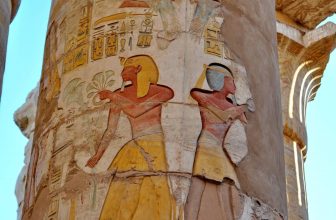Medinat Madi literally translates as “the city of the past.” A record discovered in the 9th century A.D. identifies the word “Madi” as the name of the place. The location is home to the ruins of a temple that dates back to the Middle Kingdom. It is highly remarkable since it is hard to discover a temple from this time period. King Amenemhat III and IV erected the temple. The temple honors the holy family of the deity Sobek, the goddess Renenutet, and their son, Horus Shedet.
Buildings that may still be identified today date from the late Roman and early Islamic eras (down to the ninth century). Ptolemaic dwellings may be discovered in the temple’s vicinity. Mud bricks, as well as inexpensive quarry stones, were employed as construction materials throughout history. Horizontal wooden inserts (typically palm wood) were used as reinforcement on many walls.
The Divine City of Medinat Madi
So yet, no public structures have been discovered in Madinat Madi. However, a significant number of churches have been found, and some of these have been cleansed. In most situations, they are simple structures. However, they are worth mentioning since comparable chapels were most likely found in a variety of locations throughout Egypt in late antiquity, but are now nearly entirely vanished.
The little church CH 84 A is a typical example. It is entirely constructed of mud bricks. Only the columns and door sills are made of stone. The ground plan consists of a three-aisled naos with no return aisle, but with the normal three-part sanctuary and a sequence of rooms connected on the outer south side, only the somewhat larger east chamber of which may be approached from the church’s interior. The remaining rooms’ entrances are on the exterior. On the west side, symmetrically in front of this complex, there is a smaller entry hall with an antechamber and staircase. A court that appears to be later may be found further to the west. The church might date back to the sixth century. The columns utilized in it are entirely made of solid. In terms of style, these are similar to Ahnas (Herakleopolis Magna) pieces and might have been manufactured in workshops there. The church CH 84 B is significantly smaller. The space for the laity is wider than it is long, and it has just four columns in its interior, which are also quite unevenly arranged. This church was most likely placed into an existing structure. When it was removed, various woodwork fragments (timbers and panels) were uncovered. CH 85 C, a third church, is the product of the renovation of a secular Roman structure. This is also almost square. It contains four columns in the interior, an apse in the east, and a little narthex in the west. Once again, all of the columns are made up of spolia. This church was repurposed as a residence in its last phase.
Other churches are still being excavated. Two of them (CH 87 D and CH 88 H) have five-aisle naos, while one (CH 88 G) has seven-aisle naos. However, none of these churches are exceptionally huge, and their length is considerably less noteworthy. CH 88 G has four berths and CH 88 H has three. The latter’s apse features a horseshoe-shaped ground plan with an inner circuit of engaged pilasters and two engaged columns at the nave doorway. CH 88 G contains a single example of a narthex in one of these multi-aisled churches.
The church CH 87 E, which was dug in the spring of 1987, has multiple entrances on each of its long sides. The sanctuary is three-tiered, as is customary. Columns border the doorways into the central and northern chambers on both sides. The third room to the south has a simpler style and was most likely used as a draconian. Further down, in the town’s southernmost section, is a rather well-preserved tiny church with a narthex and four interior columns. It contains a multi-room sanctuary with several components arranged around the central altar chamber.
Tours to Fayoum Oasis
Tours to Medinat Madi are available, and they are prepared by a team of expert tour guides and tour managers. Join one of Egypt Fun Tours’ El Fayoum tours and explore Medinat Madi.














